
|
![]()
Greatest Films of the 1940s
1940 | 1941 | 1942 | 1943 | 1944 | 1945 | 1946 | 1947 | 1948 | 1949
Title Screen Film Genre(s), Title, Year, (Country), Length, Director, Description 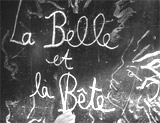


La Belle et La Bete (1946, Fr.) (aka Beauty and the Beast), 96 minutes, D: Jean Cocteau
This fanciful and enchanting story has been remade many times, both as short silent and talkie versions, and most memorably as Disney's animated film in 1991. Writer/director/painter-poet Jean Cocteau produced this first feature film, and asked the audience as the film started: "I ask of you a little . . . childlike simplicity." It was adapted from a classic 1757 fairy tale by French novelist Jeanne-Marie Le Prince de Beaumont, the story of how commoner Belle/Beauty (Josette Day) saved her father (Marcel André) by giving herself to a repulsive Bete/Beast (Jean Marais). The major theme was finding beauty beneath outward appearances, told with some obvious Freudian symbolism and haunting, surreal and atmospheric images. The magical and visually-beautiful film began with an introduction to the four siblings of a family now destitute due to the failure of their father's merchant shipping business. There were two wasteful, spoiled, haughty, evil and vain sisters: Adélaïde (Nane Germon) and Félicie (Mila Parély), and the hard-working, enslaved and devoted Belle. The fourth sibling was their lazy wastrel brother Ludovic (Michel Auclair), who protectively sheltered Belle from the romantic pursuits of his handsome friend - the shallow scoundrel Avenant (also Jean Marais). One dark night in the forest when returning home after a failed business trip, the father was taken prisoner in an extravagant and magical palace castle by the resident angry and grotesque half-man, half-Bete - for the crime of taking one rose bush blossom. He was given the choice within three days of dying himself, or having one of his three daughters replace him. The self-less and childlike Belle chose to take her father's place and sacrifice herself as a hostage, but soon found that her repulsive-looking captor treated her with kindness, politeness and riches. Slowly, she began to develop an affection for the cursed and virile Bete, who met her every evening at 7 in the dining room, and asked to marry her. When she left for a few days to attend to her sick father, she found the Bete dying (of heartbreak) upon her tardy return. He was transformed, and a spell was broken, when she expressed deep sorrow and love for him. He was now a charming Prince (also Jean Marais), while Avenant now came under the spell as the new Bete. In the film's happily-ever-after conclusion, the transformed Beast - now a new Prince - revealed that a fairy had cursed him, because his parents didn't believe in fairies. Belle and the Prince returned to the castle by flying. They were to live there, with the father and her sisters, who would now serve her.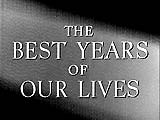



The Best Years of Our Lives (1946), 172 minutes, D: William Wyler
A landmark, classic drama, and Best Picture-winning film - both powerful and provocative with many touching moments in the lives of combat survivors now returned to their former lives, with both hopefulness and poignancy. With great acting, story-telling, direction by Wyler, and pacing, as it told about three WWII veterans attempting readjustment to peacetime life and discovering that they had fallen behind. Perhaps the most memorable film about the aftermath of World War II, it unfolded with a number of great plot threads about the homecoming of three servicemen to their small town: Army Sergeant Al Stephenson (Fredric March) who turned to drinking, Air Force major Fred Derry (Dana Andrews) who was rejected by his spouse Marie Derry (Virginia Mayo), and seaman Homer Parrish (Harold Russell) who had lost both arms and agonized over his relationship with his girlfriend Wilma Cameron (Cathy O'Donnell). The homecoming scene of Al Stephenson when his wife Milly (Myrna Loy) sensed his presence, was deeply moving. The compassionate movie portrayed the reality of altered lives, readjustments at work, dislocated marriages and the inability to communicate the experience of war on the front lines or the home front. This was the first picture for Harold Russell, a non-actor and war veteran who was an actual amputee, who won two Oscars for the same role (a unique achievement) - Best Supporting Actor, and a Special Honorary Oscar "For bringing hope and courage to his fellow veterans through his appearance..."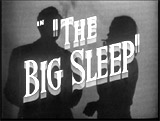



The Big Sleep (1946), 114 minutes, D: Howard Hawks
Classic atmospheric film noir mystery with crackling dialogue, from Raymond Chandler's first novel, with an incomprehensible plot (and tortuous story line) scripted by William Faulkner (with Jules Furthman and Leigh Brackett). It set the standard for private detective movies. Remade in 1978 with Robert Mitchum. It told about a down-at-the-heels private investigator Philip Marlowe (Humphrey Bogart). He had been hired by General Sternwood (Charles Waldron), a dying, invalid millionaire to look into drugs, blackmail, nymphomania, pornography, decadence and murder - and to follow after and protect his sharp-tongued, indiscreet, thumb-sucking, unstable nymphette daughter Carmen Sternwood (Martha Vickers). The private eye became sexually attracted to the older, sultry daughter Vivian (Lauren Bacall). In the twisting conclusion, Marlowe described his suspicions to gambler Eddie Mars (John Ridgely) that Carmen had killed her father's missing companion Regan, out of jealousy over an imaginary relationship between Regan and Mrs. Mona Mars (Peggy Knudsen). [Note: Mona was discovered hiding out at Huck's Garage, to make it look like she had run away with Regan during their entirely manufactured affair.] At Vivian's request, Mars had covered up the killing to "protect" her sister Carmen from guilt - and to prevent her sick father from any further suffering. Mars' cold-blooded hired killer Canino (Bob Steele), hid Regan's body and the deception was set up. Mars then blackmailed Vivian for money and sexual favors. Mars was set up to be killed by his own henchmen, allowing Marlowe to protect Carmen (who was sent "away" to an institution) and Vivian by pinning the murder of Regan on Mars - and Marlow was also able to end up with Vivian.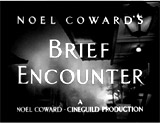




Brief Encounter (1946, UK), 85 minutes, D: David Lean
Based on a Noel Coward play - a poignant, sensitively-told, restrained British melodramatic romance about forbidden passion in a brief platonic affair. It was the quintessential, desperate tale of unconsummated illicit love. The romanticism of the film was enhanced by Rachmaninoff's Piano Concerto No. 2 musical score. It told about two married strangers who met and developed a forbidden romance. Idealistic married local doctor, Dr. Alec Harvey (Leslie Howard) and middle-class suburban housewife Laura Jesson (Celia Johnson), stuck in a loveless marriage, had a chance meeting one Thursday on the platform of a train station. Their casual friendship soon turned into a romantic relationship and they fell in love, although a planned tryst to consummate their affair was aborted. They agreed to separate and stop seeing each other when he took an assignment in another country - a medical journey to South Africa. During their final day together, they were interrupted by Laura's talkative friend Dolly Messiter (Everley Gregg) during their last, painful, repressed goodbye (both at the start and end of the film) as Alec gently placed his hand on her shoulder and disappeared forever. This was followed by Laura's near suicide attempt, before she returned to her thankful husband Fred (Cyril Raymond).



Duel in the Sun (1946), 138 minutes, D: King Vidor
Critically nicknamed "Lust in the Dust" by its detractors, although it still remains one of the top box-office westerns - in inflation-adjusted dollars. The ambitious scandalous production from David O. Selznick was a "Gone With The Wind"- type grand western with an amour fou tale. It was directed by King Vidor (who quit and was one of eight directors and cinematographers). This lurid Technicolor western, set in Texas in the 1880s at the Spanish Bit cattle ranch, was a sprawling, overheated melodramatic saga of sexual longing that was forced to cut nine minutes of its content before widespread release. Jennifer Jones starred as orphaned, 'half-breed' gypsy Pearl Chavez, who was taken in by her father Scott's (Herbert Marshall) second cousin and ex-lover, Laura Belle McCanles (Lillian Gish). Laura was the long-suffering, weak wife of crippled Senator Jackson McCanles (Lionel Barrymore), the patriarch of the cattle baron family. Pearl was soon caught in a destructive love triangle between the two McCanles sons: (1) Joseph Cotten as moderate and cultured Jesse who had studied law, and (2) Gregory Peck as hot-tempered, amoral Lewt, both Cain and Abel archetypes. In the violent orgiastic, melodramatic ending, Pearl and Lewt shot each other to the death at Squaw's Head Rock and died in each other's arms.



Gilda (1946), 110 minutes, D: Charles Vidor
The film-noirish screenplay by Marion Parsonnet (and adapted by Jo Eisinger), was taken from an original story by E. A. Ellington. The semi-trashy, steamy crime drama was known for the erotic strains of the strange, tawdry, aberrant romantic triangle (menage a trois) between the three main characters. The film's themes included implied impotence, misogyny and homosexuality, although only suggested with liberal euphemisms and innuendo to bypass the Production Code. The titular femme fatale Gilda Mundson Farrell (Rita Hayworth) was put into the care and keeping by her ex-lover (a gambler and small-time hood) and bodyguard Johnny Farrell (Glenn Ford) - the right hand man of her disagreeable South American casino-owning husband Ballin Mundson (George Macready), a mobster. It also featured the seductive striptease (to the tune of Put the Blame on Mame) when sultry Gilda removed long black satin gloves from her arms onstage. When Mundson disappeared and was presumed dead, Gilda and Farrell resumed their dangerous affair, while Farrell ran the casino - but then Mundson vengefully returned. The complex, eccentric, perverse, and cynical tale was in keeping with the prevailing attitudes of the American post-war era, playing upon US political paranoia of German-Nazi war criminals who escaped and assumed new identities in South America. [Note: Another similar plotline was found in Hitchcock's Notorious (1946)].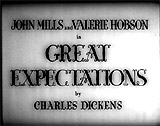




Great Expectations (1946, UK), 118 minutes, D: David Lean
This definitive British drama was based on Charles Dickens' novel (and the first of two films director David Lean adapted from Dickens' works), with deserved Oscar wins for its detailed set design and black-and-white cinematography. It told about an orphaned British boy befriended by a mysterious benefactor, and later becoming a gentleman of means (a man of "great expectations"). It has long been considered one of the best adaptations ever made of a Dickens novel, and one of the finest British films of all-time. It began with the voice-over: "My father's family name being Pirrip, and my Christian name, Phillip, my infant tongue could make of both names nothing longer or more explicit than 'Pip'. So I called myself Pip and came to be called Pip." Then it proceeded to a very memorable, gloomy opening sequence of young Pip (Tony Wager) meeting escaped convict Abel Magwitch (Finlay Currie) in a graveyard. Pip then served as a hired playmate to a young adoptive daughter named Estella who was cared for by a wealthy, eccentric, and mysterious older woman in an dilapidated estate. Later, Pip was given a financial fortune (an allowance and funds for education) from an unknown source (not Miss Havisham!), and opportunistically became wealthy and cultured, although snobbish. All of the Dickens' characters were faithfully portrayed - John Mills took the role of the older Pip and Jean Simmons as the young Estella, Martita Hunt as Miss Havisham, and Francis L. Sullivan (who played the same role in the 1934 Hollywood version) as Mr. Jaggers, Miss Havisham's lawyer.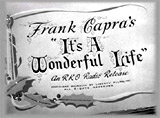


It's A Wonderful Life (1946), 129 minutes, D: Frank Capra
Sweet-natured, sentimental, inspirational classic drama about a near-suicidal man learning the value of his existence. A charitable, hard-working philanthropist George Bailey (James Stewart), forced to remain in a small town by unpredictable circumstances, became depressed after an accidental financial disaster at his loan company benefitted the miserly Mr. Potter (Lionel Barrymore). He was on the verge of committing suicide and wishing that he had never been born - when his crusty-but-lovable guardian angel Clarence (Henry Travers), who was desperately trying to earn his wings, showed up to give him a tour of his town without his presence (Bedford Falls became the decadent and hellish Pottersville), showing him how important he'd been to the lives of his loved ones. Moral courage, small-town American life, civic cooperation, and family love were glorified while corporate greed and selfishness were condemned, climaxed by the man's rescue during an idyllic Christmas card finale. Clarence earned his wings and George learned that wealth is measured in love and friendship.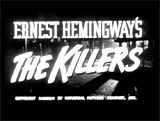


The Killers (1946), 102 minutes, D: Robert Siodmak
A classic, definitive film noir, from a short story by Ernest Hemingway, told in eleven taut flashbacks after a bravura opening murder sequence. Two hit men Al (Charles McGraw) and Max (William Conrad) entered a greasy-spoon diner in Brentwood New Jersey, asking the manager about Ole 'Swede' Andersen (Burt Lancaster, in his film debut) - a gas station attendant. The doomed 'Swede' (an ex-boxer), who had been hiding in town under an alias for six years, was warned in a nearby boardinghouse. Indifferent, he expected their arrival and calmly, passively awaited their deadly approach. Insurance investigator Jim Reardon (Edmond O'Brien) pieced together and unraveled the plot and reconstructed the life of the victim through interviews and detective work. He discovered a complex tale of crime and treacherous betrayal - all revolving around a beautifully-glamorous, mysterious, double-crossing femme fatale Kitty Collins (Ava Gardner) - who sang "The More I Know of Love." The film's main theme (with a rising and falling dum-de-dum dum) from composer Miklos Rozsa was later borrowed for the opening sequence of TV's Dragnet.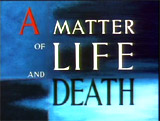


A Matter of Life and Death (1946, UK) (aka Stairway to Heaven), 104 minutes, D: Michael Powell, Emeric Pressburger
Reminiscent of other heavenly fantasies, including Here Comes Mr. Jordan (1941) and Down to Earth (1947). One of the most innovative, visually-dazzling (from cinematographer Jack Cardiff), literate, and audacious films ever made by the extraordinary writer/producer/director team of the Archers production company: Powell and Pressburger. The film was an extravagant and extraordinary fantasy in which WWII RAF pilot and squadron leader Peter David Carter (David Niven) must abandon his fiery bomber (returning from a raid over Germany) without a functional parachute. Knowing his fate was doomed, he nonetheless fell deeply in love with British-based, WAC radio operator and ground controller June (Kim Hunter) as they shared a few last words. In a film that continually begged the question, what was real and what was imagined, he awakened unharmed on a beach after falling to his 'death', due to errors made by heavenly emissary Conductor 71 (Marius Goring) in the fog. During brain surgery to rid him of alleged hallucinations, his spirit was put on trial -- and he had to justify his continuing existence on Earth to a panel of heavenly judges in a celestial court (with God (Abraham Sofaer) as his judge, recently-deceased friend Dr. Frank Reeves (Robert Livesey) as his defense lawyer, and Abraham Farlan (Raymond Massey) as the prosecutor). He had to convince them that he should survive and wed his romantic sweetheart June. In a bold stroke, the Heavenly sequences were filmed in black-and-white, while the Earthbound scenes were in vibrant, ravishing Technicolor. The film used various then-revolutionary film techniques such as time-lapse photography, mixing monochrome and color in the same shot, and background time-freezes when a spirit left the body, reminscient of The Matrix (1999). One shot typified just how different the film was -- a point-of-view (POV) shot from within an eyeball during brain surgery. The most spectacular dream sequence was the slow ascent to heaven on a giant stairway, and the film's most memorable image was of a single, glittering love tear on a red rose petal.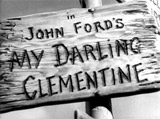

My Darling Clementine (1946), 97 minutes, D: John Ford
One of John Ford's greatest westerns, semi-historically based on the famous O.K. Corral gunfight - inevitably visualized in the conclusion. Henry Fonda starred as Wyatt Earp, a one-time outlaw gunslinger who became the dedicated, law-abiding sheriff of Tombstone, Arizona during the 1880s, determined to clean up the rowdy frontier town where the killers of his brothers, led by Old Man Clanton (Walter Brennan), had fled. A visit to the barber symbolized Earp's transition from the western frontier to civilization - as well as his romantic relationship with the title's female character. He developed a relationship with the legendary consumptive gunfighter Doc Holliday (Victor Mature) - originally a cultured Bostonian, defended a drunken Shakespearean actor, and cultivated a romance with square dance partner Clementine (Cathy Downs), the town's school teacher.


Notorious (1946), 101 minutes, D: Alfred Hitchcock
Hitchcock's ninth Hollywood film, the highly-acclaimed, post WWII noirish spy thriller/romance set in Brazilian South America. An alluring, alcoholic playgirl Alicia Huberman (Ingrid Bergman), the daughter of a convicted Nazi agent, was reluctantly exploited and drafted by the CIA to become a US government agent and secretly infiltrate into a shady group of Axis Germans. Watchful American agent Devlin (Cary Grant) turned chilly toward her, uncertain of her love and loose-living past during a cruel love affair. To spite him when he didn't protest, she married her Nazi espionage target Alexander Sebastian (Claude Rains), a former friend of her father's, to acquire access to information, including the MacGuffin (uranium in wine bottles) in his wine cellar. Trapped in her enemy's home, where her husband was oppressed by his cold, domineering mother Mme. Sebastian (Leopoldine Konstantin), Alicia was slowly poisoned with arsenic and in mortal danger until rescued by guilt-ridden Devlin. The film featured the most famous marathon screen kiss in film history, the zoom shot toward the wine cellar key, the wine cellar sequence, and the staircase-descending finale.

Paisan (1946, It.) (aka Paisà), 120 or 134 minutes, D: Roberto Rossellini
An important neo-realistic Italian docu-drama co-written by director Rossellini and Federico Fellini, and filmed in an authentic, documentary style with improvisational dialogue. An extremely powerful compilation of six episodes or vignettes - depicting the Allied invasion and liberation of Italy (from Sicily to Venice) during WWII, from July 1943 to the winter-spring of 1944. It surveyed a small group of people affected by the war on a day-to-day basis: a non-English-speaking Sicilian female (Carmela Sazio) guarded in a cave by American GI Joe (Robert Van Loon), black MP Joe (Dots M. Johnson) and his street urchin companion Pasquale, a love-sick American soldier Fred (Gar Moore) in Rome mistakenly believing that his dream girl Francesca (Maria Michi) wasn't a prostitute, an American nurse (Harriet White) and her wounded and dying partisan leader boyfriend (Gigi Gori), the sequence in a Franciscan monastery involving three Army chaplains of different faiths and the withdrawn monks, and the final action sequence at the Po River between the partisans and OSS men fighting the Germans.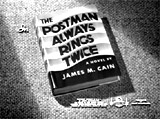


The Postman Always Rings Twice (1946), 113 minutes, D: Tay Garnett
A stylish moody adaptation of James M. Cain's torrid crime melodrama - one of the best film noirs, about the murderous effects of lust. Handsome drifter Frank Chambers (John Garfield) was hired at the California roadside Twin Oaks diner/restaurant as a handyman by kindly, middle-aged proprietor Nick Smith (Cecil Kellaway) after one look at his sizzling, lustfully white-hot (and unhappy), platinum-blonde waitress wife Cora (Lana Turner). The slow-burning fuse of sexual passion between Frank and adulteress Cora led to their plot to 'accidentally' kill her husband. After the murderous couple's plot was executed following a failed first attempt, they betrayed each other and were undone by their own uncontrollable, calculating natures, even as Cora admitted before her death in an automobile crash: "When we get home, Frank, then there'll be kisses, kisses with dreams in them. Kisses that come from life, not death."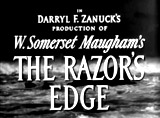



The Razor's Edge (1946), 146 minutes, D: Edmund Goulding
An outstanding drama taken from W. Somerset Maugham's novel, although long, gloomy and rambling, about the search for life's intellectual and spiritual meaning - and enlightenment. After idealistic, wealthy young Larry Darrell's (Tyrone Power) world was shaken, traumatized and disillusioned by the horrors of WWI (after he served in the war as a pilot and narrowly escaped death), he restlessly set out again to seek truth and goodness. In Chicago, wealthy, upper-class, social-climbing Isabel Bradley (Gene Tierney) offered him love and stability as his fiancee, but he rejected her, renounced wealth, and traveled to Paris' backstreets and later took a pilgrimage to the mountains of Nepal. In Paris, Isabel was forced to give up on a plan to trap him into marriage by feigning pregnancy. With the aid of an old mystic Hindu guru, Holy Man (Cecil Humphreys), Larry eventually found peace and freedom. When he returned almost a decade later to Paris, he was reunited with Isabel and other former friends, and learned that they all had suffered challenging experiences. He aided former childhood friend, Sophie Nelson (Oscar-winning Anne Baxter) whose husband Bob MacDonald (Frank Latimore) and child were killed in an automobile accident. She had resorted to alcoholism and prostitution in a lower class district of Paris, but with his efforts, Larry was bringing the widow to sobriety and soon became engaged to marry her. However, strong-willed Isabel, who had married someone else - multi-millionaire Gray Maturin (John Payne) who had lost his wealth in the stock market crash and suffered a nervous breakdown - was resolute on reigniting her relationship with Larry. Isabel jealously conspired to cause Sophie's demise. Larry blamed Isabel for encouraging Sophie to be self-destructive by returning to drink, and refused to reconcile with her - he concluded the film having found happiness and true goodness.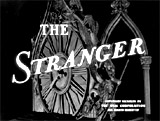



The Stranger (1946), 95 minutes, D: Orson Welles
An impressive film noir starring and directed by Orson Welles - it was his first suspense-thriller. Keen-minded United Nations War Crimes Commission government agent-investigator Mr. Wilson (Edward G. Robinson) was on the trail of Nazi war criminal, fugitive agent Franz Kindler (Orson Welles). In the small and sleepy Connecticut town of Harper, the deceitful Kindler was posing as Charles Rankin, a respectable New England prep school teacher, engaged to marry Mary Longstreet (Loretta Young) - the daughter of respectable Supreme Court Justice Adam Longstreet (Philip Merivale). Mary was unaware of her fiancee's notorious past as the mastermind of the genocidal Holocaust. To prevent being exposed, Kindler strangled his former associate Meinike (Konstantin Shayne). To get to his quarry in a tense cat-and-mouse game, Wilson (posing as an antiques dealer) had to convince the suspicious Mary of her fiancee's crimes, before he eliminated her too. In the exciting conclusion, topped by a chase-finale on a church belfry tower, Mary discovered Rankin's plot to kill her and dared him - and when prevented and pursued, he fell to his death.

To Each His Own (1946), 122 minutes, D: Mitchell Leisen
This was star Olivia de Havilland's first screen role after winning a landmark Supreme Court case against Warners, reducing exploitative studio control of actors to seven years. Similar in plot to Edmund Goulding's The Old Maid (1939) with Bette Davis. A superior, sentimental romantic melodrama (or women's "weepie"), told in flashback by an unwed mother (now a middle-aged American expatriate, and a fire-watch warden in London during an air-raid beat) who encountered the son she had given up for adoption many years earlier. Miss Josephine 'Jody' Norris (Best Actress-winning Olivia de Havilland) recalled a passionate, small-town love affair in Pierson Falls in upstate New York with Captain Bart Cosgrove (John Lund in his debut film), a pilot who presumably died during action in WWI (the Great War). She was painfully forced to give up her son for adoption to another family to avoid scandal. Her son was taken in by Corinne (Mary Anderson) and Alex Piersen (Phillip Terry) when Jody maneuvered herself out of the right to call the child her own. Afterwards, Jody spent years devoted to a successful cosmetics business, while her grown son American Lieutenant Gregory 'Grigsy' Pierson (also John Lund) only knew her through casual contact and presents (given by "Aunt Jody" - known as a friend of his "mother"). When he visited and revealed his attachment to girlfriend Liz Lorimer (Virginia Welles), Jody's aristocratic confidant and love interest Lord Desham (Roland Culver) helped their romance lead to marriage, and broadly hinted to Gregory the identity of his biological mother, in the tear-jerking happy conclusion. Liz also tipped off Grigsy: "Anyone would have thought you were her only son" - he then approached his mother on a dance floor and asserted: "I think this is our dance, Mother."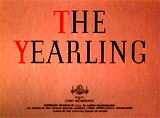

The Yearling (1946), 134 minutes, D: Clarence Brown
A beautiful and sensitive film, based on the 1938 Pulitzer Prize-winning novel by Marjorie Kinnan Rawlings. Remade for TV in 1994. An inspirational family-oriented, coming-of-age dramatic story about a young boy who matured after confronting the harsh realities of life - accepting a final goodbye to his beloved animal friend. In the late 1870s, somber, overprotective and stern Orry (Jane Wyman) and kind-hearted, understanding Penny Baxter (Gregory Peck) lived in the remote Florida wilderness (Baxter's Island) where they eked out a living on their farm. Sole surviving child, fresh-faced and pleasant Jody (Claude Jarman, Jr. in his screen debut), a lonely 12 year-old son, longed to have a pet to keep him company. Due to dire circumstances, Penny was compelled to orphan a fawn - after being bitten by a rattlesnake, he killed a doe to use its organs to release the poisonous venom. The yearling fawn, named Flag, grew closer and attached to Jody, but problems developed - it ate the pioneer family's hard-won crops of tobacco and corn, and the boy was forced to accept a painful, heart-wrenching decision. Rather than shoot the yearling, Jody released him into the woods. Tough-minded Orry shot and wounded Flag, and tearful Jody finished him off. Jody ran away, but then returned home after three days, to his relieved parents.